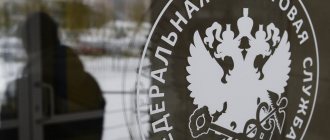It is believed that participation in a tax audit strengthens the professional skills of an accountant. Based on this judgment, we dare to assume that thorough preparation for it will come in handy. Order of the Federal Tax Service of Russia dated May 30, 2007 N MM-3-06/ [email protected] (as amended on May 10, 2012) approved the Concept, according to which an organization is subject to an on-site tax audit if it meets one of twelve criteria specified therein.
Agree, the very fact of a tax audit is an aggravating event. An even more unpleasant phenomenon is her waiting. The Federal Tax Service, when it issued the Order “On approval of the Concept of the planning system for on-site tax audits,” did not provide for the opportunity for legal entities to know for sure whether this audit would take place or not. The criteria specified in it are a kind of guideline for companies. If you are moving in the direction “necessary” for the Federal Tax Service (which we will discuss below), then you may not meet tax inspectors at the door and treat them to tea and cookies. At the same time, the Federal Tax Service does not give any guarantees that full compliance with these 12 criteria will protect you from anything.
Concept for planning on-site tax audits
In order to monitor taxpayers' compliance with the legislation on taxes and fees, the Federal Tax Service authorities are vested with the right to conduct on-site tax audits (ATI).
Making a decision to conduct an on-site tax audit in relation to a certain person does not occur spontaneously and solely at the request of the inspection inspector. This decision is determined by the presence of certain factors and circumstances, the understanding of which will allow you with a high degree of probability to understand whether to expect an inspection soon or not.
The aforementioned Order of the Federal Tax Service of the Russian Federation dated May 30, 2007 No. MM-3-06/ [email protected] , since Appendix 2 contains criteria for self-assessment of risks for taxpayers. We wrote about how to use these criteria in the article “Tax burden by type of activity: the Federal Tax Service is coming to us.”
Borderline indicators for special regime officers
For the application of special tax regimes, the Tax Code establishes certain thresholds. Once they are exceeded, the application of the tax regime will be prohibited.
For example, for the simplified tax system the following values are set:
- annual income should be no more than 150 million rubles ;
- the residual value of fixed assets is also no more than 150 million rubles ;
- share of organizations in the authorized capital - no more ¼;
- number of employees - no more than 150 people.
If over the course of a year, for example, annual income approaches the specified amount, and then “rolls back”, this may raise suspicion. Isn’t income being understated so that the simplified tax system can continue to be applied? The same applies to the remaining limit values.
Making a decision to conduct a pre-screening analysis (PVA) in relation to a person
One way or another, the Federal Tax Service checks all taxpayers. And the very first filter is to determine the circle of persons in respect of whom the PPA will be carried out.
The selection of taxpayers for conducting an on-site tax audit is carried out by the fiscal authorities on the basis of:
- Order of the Federal Tax Service of Russia dated May 30, 2007 No. MM-3-06/ [email protected] “On approval of the Concept of the planning system for on-site tax audits”, which defines 12 criteria that negatively characterize the taxpayer;
- information regarding a specific taxpayer received from a higher body of the Federal Tax Service (UFTS of Russia for the subject);
- information regarding a specific taxpayer received from other departments of the inspectorate (for example, from the desk tax audit department).
The decision to carry out a PPA in relation to a tax payer is not formalized, it occurs on a routine basis and the payer himself is not informed about it.
An entrepreneur's expenses are approaching his income
Individual entrepreneurs in the main tax regime pay personal income tax on their own income, reduced by the amount of tax deductions - documented expenses. If expenses are close to income, then there is nothing to pay tax on. Therefore, if expenses are very high, there may be a suspicion that they are artificially inflated.
It is believed that the safe share of individual entrepreneur deductions is 83%. If within two years an entrepreneur’s expenses amount to more than 83% of income, then this may become a reason for suspicion and the appointment of an income tax.
Carrying out PPA in relation to a person
If your company eventually comes to the attention of the tax authorities for the reasons described above, this does not mean that an IRR is guaranteed to be carried out against it. Today, the Federal Tax Service is rightfully faced with the task of increasing the efficiency of control in the area of accrual and payment of taxes and fees. This means that before making a decision to conduct a tax return, the fiscal authority must already have preliminary information about potential violations of tax laws by a person, as well as the possibility of actually collecting from him the expected amounts of additional taxes, penalties and fines.
It is for this purpose that a PPA is carried out in relation to taxpayers, within the framework of which the Federal Tax Service authorities use the following tools and sources of information:
- Request information from other government bodies (Federal Customs Service of Russia, Rosimushchestvo, Ministry of Internal Affairs, etc.).
- Requesting information from the taxpayer's counterparties and banks in accordance with Art. 93.1 Tax Code of the Russian Federation.
- Information about the taxpayer from general information sources on the Internet.
- Information about court cases involving taxpayers.
- Some control measures provided for in Ch. 14 of the Tax Code of the Russian Federation (inspection of premises, requesting explanations, etc.).
- Use of specialized information resources of the Federal Tax Service (for example):
- ASK VAT-2 allows you to install the so-called. “tax gap” in the VAT chain;
- PIK "Odnodnevka" - a database of "technical" companies;
- FIR (federal information resource) - database of interrogations, examinations, 2-NDFL certificates;
- PC "VAI" (visual information analyzer) - identifies interdependent persons, sources of their income and other information.
Based on the results of the PPA, a conclusion is issued that reflects the following information:
- The feasibility of conducting a GNP.
- Recommended plan of activities that will need to be carried out within the framework of the GNP.
- Recommendations on the composition of inspectors (including the need to include representatives of law enforcement agencies in their composition).
- The potential amount of additional charges based on the results of the GNP.
- Possibility of actual recovery of additional amounts accrued based on the results of the GNP.
Low level of profitability
Profitability is an indicator of the efficiency of resource use. Return on sales is calculated using the formula:
Profit from sales / Cost * 100%
Return on assets is calculated as follows:
Profit / Assets * 100%
For example, let's calculate the return on sales. Let the owner of a cafe receive a profit of 600 thousand rubles at the end of the year, and the cost of his products amounted to 7 million rubles. The profitability of sales will be:
600 000 / 7 000 000 * 100% = 8,57%
At the end of each year, the Federal Tax Service calculates the profitability of each area of activity. In public catering it is 7%. It turns out that the businessman from the example is above the reference level in terms of return on sales. This means that according to this indicator he is out of the risk zone.
Deadlines
The period for conducting an on-site tax audit (that is, the period during which an on-site audit can be carried out), in accordance with clause 6, paragraph. 5 paragraph 7 art. 89 of the Tax Code of the Russian Federation is:
- 2 months - as a general rule;
- up to 4 or even 6 months - if there are circumstances that allow you to extend the period. They are listed in Appendix No. 4 to the Order of the Federal Tax Service of Russia dated 05/08/2015 No. ММВ-7-2 / [email protected] (for example, such as the presence of separate divisions in the company, force majeure - fires, floods, etc., the emergence of new information about tax violations, etc.);
- up to 1 year, if, in addition to extending the inspection period, decisions are made to suspend it on the grounds specified in clause 9 of Art. 89 Tax Code of the Russian Federation.
Interaction with unreliable counterparties
You can end up on the list of candidates for an on-site inspection not only for your own sins, but also because the businessman found yourself in bad company. After all, when choosing contractors, he must exercise caution. If one-day companies appear among the partners, the Federal Tax Service may suspect the company of wanting to receive an unjustified tax benefit . Or blame, at a minimum, the fact that management did not take proper security measures and did not check the counterparty.
Such a check involves requesting constituent documents, confirming the powers and identity of the director, checking information about the company in open sources, as well as obtaining data from the Register of Legal Entities or Individual Entrepreneurs. We recommend reading a detailed article on how to assess the reliability of a partner and avert the suspicions of tax authorities.
One-day counterparties are dangerous because they may not pay the VAT that you claim for deduction. If there is a suspicion that one of the counterparties could have acted in such bad faith, it is recommended to exclude the VAT amounts presented to him from deductions. And if such deductions have already been claimed, restore the tax and submit an updated return.
Instead of a resume
Analysis of the recommendations of the Federal Tax Service, in general, confirms the trends that have developed over the past few years.
- The Tax Service is relying on the automation of taxpayer selection mechanisms, which are focused on compliance with certain average statistical indicators. In this regard, it is fundamentally important to (a) know the necessary parameters and (b) comply with them.
- At the stage of pre-verification activities, the tax service does a lot of work, as a result of which evidence is already generated that justifies additional tax assessments.
- Legalization commissions have priority over the conduct of the GNP. It is obvious that the tax service is striving to do more with less money, since the “cost” of an on-site audit is much higher than the incentive procedure for voluntarily clarifying one’s tax obligations.
Voluntary clarification
In its recommendations, the Federal Tax Service directly states that if there is objective evidence of tax offenses, before including a taxpayer in the audit plan, he should be given the opportunity to voluntarily pay taxes.
The mandatory nature of this procedure is confirmed by current practice, since the so-called legalization commissions have become almost the main means of the tax service to increase tax collection.
However, in a number of cases, work aimed at voluntary clarification of tax obligations may not be carried out:
- there is an order from a higher authority to include the taxpayer in the draft GNP plan;
- there is reason to believe that if a commission is held, the taxpayer will take measures to reorganize or migrate to another region;
- within three years before the consideration of the issue, the taxpayer was sent requests for explanations, and he did not respond to them in any way, including not specifying the amount of taxes to be paid and did not refuse to use the tax evasion scheme.
The legalization commission itself is an absolute blessing. Firstly, participation in this event allows the taxpayer to convey his position to the inspectors, which, perhaps, will remove all claims altogether. Secondly, it provides the opportunity to pay additional tax without penalties.
Important! The Federal Tax Service's recommendations directly indicate that clarification of tax obligations is not a 100% guarantee of avoiding an audit. After the additional payment, the company may not be included in the draft GNP plan, or it may be included. Accordingly, even after a seemingly successful completion of the commission, the taxpayer should not have the illusion of security.
In addition, it is important to understand that the very clarification of tax obligations based on the results of the commission indicates that the inspectors are working in the right direction and the taxpayer has something to hide. Submission of an updated declaration provides the basis for conducting a desk audit of the past period. See. Letter of the Federal Tax Service dated September 26, 2021 No. ED-4-2/17979, which inspectors sometimes take advantage of, forgetting about “gentlemanly” agreements.
Online service for calculating the tax burden of companies and individual entrepreneurs
Let's briefly explain how it works.
In the left column fill in:
- the year for which we calculate the tax burden (for example, 2018);
- type of economic activity (for example, clothing production);
- subject of the Russian Federation (for example, our clothing manufacturer in Moscow).
In the right column we write how much and what taxes the company paid for 2021 (in thousands of rubles):
- amount of taxes actually paid, total = 5,500 thousand rubles;
- Mineral extraction tax and excise taxes = 0 thousand rubles;
- corporate income tax = 2,900 thousand rubles;
- VAT = 2,600 thousand rubles;
- total amount of income = 100,000 thousand rubles.
Click “Calculate actual indicators”. We are taken to the bottom of the page, where a small table appears, which indicates:
- industry averages;
- indicators of our company (actual tax burden);
- deviation from the industry average load.
In our example, the company deviates towards paying more. This means that the Federal Tax Service will have no questions regarding the tax burden.
Formula for calculating a company's tax burden
It is simple: the amount of taxes paid according to statistical reporting is divided by turnover (revenue).
Example. Alpha LLC at OSN. Engaged in construction. Revenue for 2021 - 32 million rubles. Taxes:
- VAT - 820 thousand rubles;
- income tax - 950 thousand rubles;
- transport tax - 200 thousand rubles;
- property tax - 520 thousand rubles;
- Personal income tax - 700 thousand rubles.
Amount of taxes paid = RUB 3,190,000.
32,000,000 / 3,190,000 rubles = 10.03%. Round up to 10%.
The tax burden of Alpha LLC is 10%. The industry average for construction companies for 2021 is 6.1%. Alpha has nothing to worry about. The Federal Tax Service will have no questions about the tax burden of this company.
Remember that according to this formula:
- Personal income tax is taken into account;
- insurance premiums and dividends are not taken into account.
However, there is no need to sit with a calculator - the tax office has created an online service where you can calculate the tax burden of an organization or entrepreneur.
EXAMPLE FROM JUDICIAL PRACTICE
In the resolution of the Ninth Arbitration Court of Appeal dated March 4, 2016 No. 09AP-2367/2016, the court came to the conclusion that there were connections with. According to the bank statement for the current accounts of Primera LLC, it was established that Primera LLC made transfers for transport services to organizations that have the characteristics (no labor personnel, managers are “mass”), namely: Prostor LLC, Prostor LLC Expoline", LLC "Doris". From the Internal Affairs Directorate for the Central Administrative District of the Main Directorate of the Ministry of Internal Affairs of Russia for the city of Moscow, the tax authority received explanations from the General Director of Investproject LLC S.V. Klyueva, who reported that she was not involved in the activities of Investproject LLC, this organization was not familiar to her, in the period 2010–2012 . she worked at the Perekrestok store as a salesperson, and also indicated that in 2008 she lost her passport. In this regard, she wrote a statement to the internal affairs authorities. Some time later I found my passport in the mailbox. S.V. Klyueva also explained that she had never conducted any activities on behalf of legal entities.
GOOD TO KNOW
An important criterion for determining the feasibility of including a taxpayer in the on-site tax audit plan is profitability. It is clear that the higher this profitability indicator, the more effective the organization’s activities. The obtained data are compared with the average indicators for the taxpayer’s main activity. A significant downward deviation is considered to be 10% from the industry average.
A similar connection with was identified in the resolution of the Ninth Arbitration Court of Appeal dated March 20, 2014 No. 09AP-5428/14. The tax authority indicates that the taxpayer and CJSC "UK ZHKH Monolit" are interdependent entities, and the relationship between them was built with the aim of obtaining unjustified tax benefits and withdrawing funds through. At the same time, only two grounds are indicated for recognizing the taxpayer as interdependent with his counterparty: the taxpayer, in the opinion of the interested party, is subordinate to the State Institution “Information System of the Novokosino District”, the head of which was Vladimir Andreevich Dukman, who owns 36% of the shares of ZAO “UK ZHKH Monolit”, and employees of DEZ Abdikeeva Elena Aleksandrovna and Lomakina Tatyana Stepanovna, each owned shares of 5% of the shares of ZAO UK Housing and Communal Services Monolit.
In addition, in practice, tax authorities are looking for opportunities to charge additional taxes by calculation. This is possible if, for example, the taxpayer does not submit documents for tax control. In the ruling of the Supreme Court of the Russian Federation dated January 25, 2016 No. 302-KG15-17939, the court refused to challenge the decision of the Federal Tax Service. Limited Liability Company "VostSibNeft" applied to the court to challenge the inspectorate's decision regarding the additional assessment of corporate income tax in the amount of 1,438,350 rubles, value added tax in the amount of 50,551,506 rubles, the accrual of penalties on these taxes in total in the amount of 16,787,759 rubles. 28 kopecks, bringing to justice under paragraph 1 of Art. 122 of the Tax Code in the form of a fine in the total amount of 4,288,131 rubles. 93 kop. The Supreme Court put an end to it, pointing out the guilt of the applicant himself, who did not submit primary and other documents to verify the correctness of calculation and timely payment of taxes. Therefore, in the court’s opinion, the additional tax assessment is lawful.
Thus, very often the tax authority is looking for an unjustified tax benefit. Evidence may vary:
- transactions with related parties;
- lack of documents;
- registration at the mass registration address, mass founder and general director;
- work with companies not located at a legal address, etc.
GOOD TO KNOW
As for the industry average workload and profitability, then, in fact, these criteria are a flirtatious fig leaf covering... What exactly can be found out by reading the correspondence of participants in the on-site inspections section of the forum of tax officials, where they are in a relaxed informal atmosphere and not particularly embarrassed in expressions, they discuss their hard lot.





